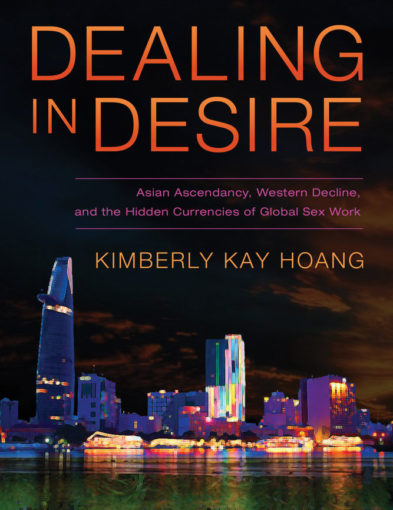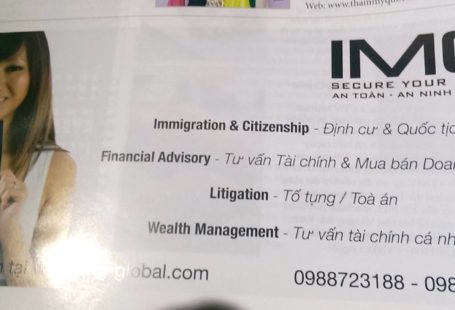Once in a while Bs. Love likes to refresh his academic knowledge by treating himself with some thoroughly researched, scholarly article. Even better if the title reads “She’s Not A Dirty Low-Class Girl!: Sex Work in Ho Chi Minh City, Vietnam.”
I found that decade-old ethnography paper (full PDF) some time ago, probably while googling Vietnamese hookers, as one does. The author, Kimberly Kay Hoang, described a “stratified sex industry” in a bygone era of the Saigon nightlife when Việt Kiều men occupied the top of the market, followed by Western backpackers then poor local men. It was a small project based on a few interviews with hookers and clients during a field trip in 2006-2007. But she was just getting started.
Now teaching sociology at the University of Chicago, Dr. Hoàng’s been digging deeper over the years into the subject of “sex work” in Ho Chi Minh City and its “complex intermingling of money and intimacy.” Of course that makes her work a gold mine of information for whomever shares her interests, and Bs. Love definitely does!
I can’t recommend enough Dr. Hoàng’s excellent 2015 book, Dealing in Desire: Asian Ascendancy, Western Decline, and the Hidden Currencies of Global Sex Work (see book cover above). You can also read online for free her 2011 Ph.D. thesis on which the book is based, New Economies of Sex and Intimacy in Vietnam (full PDF). If you’re too lazy, here’s my summary with some comments.
Building on her earlier insights (see “Dirty Girl” paper above), Kimberly Kay Hoang returned to Vietnam in 2009-2010 to conduct ethnographic research as a participant observer. She worked alongside “sex workers” as a hostess in four bars catering to wealthy East Asian investors, Việt Kiều pilgrims, Western expats, and Western backpackers. In each venue she studied how the girls adapted their behavior and appearance to each clientele, how they played on transnational and racial perceptions to extract as much money as possible from foreign bank accounts, and how their informal work very much contributed to the growth of the formal economy. Here’s how she sums up her findings:
Sex workers develop an emotional product that is specially tailored to the particular relations they seek to develop with their clients. (…) Racialized desires, status, business success, and hope for upward mobility are all played out in the bars of HCMC, where dreams and deals are traded. This sex industry is not just a microcosm of the global economy; it also helps fuel its growth.
In her total 24 months in the field she hung out with hundreds of “sex workers”, clients, “mommies”, bar owners and other market participants in order to paint a FASCINATING portrait of the hostess bar scene of the 2010s, based on sound methodology and comprehensive literature. The resulting thesis and book are not only great reads, they’re very serious pieces of ethnographic research.
Rise and fall of the Việt Kiều
A mere three years after her first trip, Kimberly Kay Hoang finds herself in a transformed sexscape where Việt Kiều men have been downgraded to second-class Johns following Vietnam’s entry into the Word Trade Organization and the arrival of Asian investors, who are now being showered with bottle service and exquisite creatures by powerful local men. “The sex industry had changed in response to macroeconomic changes”, she notes. In 2006 Việt Kiều remittances were double the $2 billion Foreign Direct Investment (FDI) brought into the country; by 2009 they only amount to a third of it. Việt Kiều men still spend much more than cheap-ass Western expats, for whom a new type of place has just been invented – the Pasteur Street girlie bar. As for the backpackers they’re relegated to the gutters of Bùi Viện (which that street probably didn’t have at the time).
Dr. Hoàng seamlessly navigates all four environments by going through a series of extreme make-overs, with the help of mommies and colleagues who pity her for being so fat and short, and by burying her Western upbringing and post-secondary education deep behind a mask of country girl submissiveness (which proves hard to do at times by her own account). All the bars in her book have long disappeared –not the mechanics at work.
A tale of four masquerades
First, she joins the elite troupe at Không Sao, a luxury place hidden in a nondescript building where wealthy Vietnamese men from the finance, real estate and trade sectors entertain their Asian business partners from Taiwan, Korea, Malaysia and China as well as local politicians. These guys typically spend four days a week and $15,000-$20,000 a month in this place, always in big bundles of cash, purposedly paying more in order to impress their guests and demonstrate how Vietnam is now a modern country and a promising place to invest. Hostesses earn roughly $2,000 a month on tips just for accompanying men at their tables, and an extra $200 for each sexual encounter outside the bar, at their discretion.
Không Sao bar is owned by people with political connections who have painstakingly designed it as a clearing house for Asian FDI. They picked up the main mommy, Hạnh, from a countryside karaoke at a very young age, grooming her up to become a shrewd entrepreneur at the center of a web of business connections that all happen at Không Sao. She’s in charge of recruiting girls who meet the high standards of the place, dressing and sitting and acting the right way depending on each man’s relation to the others. As a result of their hard work, “bars like this are responsible for much of the country’s recent economic growth”, Dr. Hoàng writes.
Interestingly these Vietnamese rich boys call themselves Việt Cộng as an ironic comment on their newfound riches and “as an implicit revenge on the colonial past”. In Dr. Hoàng’s observation the whole place is a stage for them to “assert dominant status in relation to other Asian businessmen, Việt Kiềus and Westerners”.
Việt Kiềus have lost their top dog position but mind you, they’re still spending a lot. Dr. Hoàng meets them at Lavender Bar, a flashy club where they take great pride in paying and tipping more than caucasian men. “White guys order beer, Việt Kiều order bottles”, one of them is quoted saying. “Many of these men experienced feelings of discrimination in their home countries in relation to white men, and the bars in HCMC [allowed them to] reconfigure, albeit temporarily, global racial hierarchies”, she writes.
Of course the Lavender staff knows this and does everything to feed VK “fantasies of celebrity”: getting their taxi door and walking them in, making them feel like stars with VIP treatment and photographers etc. while caucasian men who have the misfortune to venture there are asked to wait in line and treated like beggars once inside the club. “Việt Kiều men tip more if you make them feel more special than white men”, says one hostess. The more they ache to flip the script on caucasian men, the more they have to pay for the privilege.
Another fantasy is at play at Lavender: the nostalgia of a long gone fatherland. The modern young women working there know they must enact the “Old Vietnam”, all cute and sweet, to win VK hearts and turn them into remote sponsors once they’re back in the West. While many clients understand the game and play it for fun, some develop “remittance relationships” with the girls and make plans to leave their VK wife and retire here with their traditional, submissive mistress. To feed this “fantasy of return” one client takes a second mortgage on his US home unbeknownst to his wife. The fools. “That men were invested in gendered differences was key to an effective masquerade that allowed workers to capitalize on men’s nostalgic remittances”, Dr. Hoàng observes.
(Caucasian) Western men are treated with their own masquerade as well. At Secrets, one of the first girlie bars now ubiquitous around Pasteur Street, Dr. Hoàng witnesses women going full Third World on expats to feed their fantasy of “Western largesse”. In contrast with the luxury bitches catering to Asian men, they do their best piss-poor girl impersonation to make Western men feel sorry for them and play the charitable benefactors. One of their “strategies to perform poverty” is to take clients on trips to meet their “fake village families”, picked among the poorest for maximum impact. A vermine-infested shack, some frail elders with hunchbacks, and a bunch of dirty kids with broken toys should be enough to pry the visiting men’s hearts and wallets wide open.
Lilly, the owner of Secrets, is a former Bùi Viện hooker who envisioned it as a platform to get more money from Westerners while giving them less pussy (this is Bs. Love’s interpretation, not Dr. Hoàng’s). Her idea really caught on, spawning a niche industry that’s still very much alive today. She confesses: “To get money out of these men you don’t let them think that you are a prostitute. You make them think that you are an innocent girl who will work hard [and] that you are looking for a real relationship but what they don’t know is that you have 20 or 30 different boyfriends.”
Dr. Hoàng describes the expat customers as mostly industry leftovers from the West who couldn’t make it in their home city post-2009 financial crisis, who brag like idiots about their dick sizes, and who insist on speaking Vietnamese so they can feel superior by using the pronoun Anh (this is a bit far-fetched IMHO, there are many better reasons to speak with Vietnamese people in their own language). Many of them know the girls are lying, but some fall into the honey trap. In addition to sending cash to their bar protégées (let me guess, she’s not like the other ones?), they bore them to death with financial advice such as saving money, investing with a sound business plan, etc. Of course the girls burn money fast and never intend to leave their lucrative bar job, not to mention they can stretch it into their late 20s, early 30s with this particular clientele.
At the bottom of the pile is Naughty Girls on Bùi Viện, where Kimberly Kay Hoang hangs out in an observer capacity, considering the girls only chat briefly with “budget travelers” before going to their hotel. Again, the girls play on the men’s “Western dominance fantasy” by pretending they’re poor village girls looking for a rescuer. Here the encounters are mostly sex-based and don’t lead to the same return on investment as at Secrets. Still, the men’s “short-term gifts” are enough to allow the owner, Tina, to own a downtown property and a car at 22.
Looking the part: From K-pop stars to Mekong trash
While most “sex workers” in Dr. Hoàng’s research come from the same poor background, they adopt widely different beauty standards for Asian or Western men. And it goes much further than white vs. dark skin: it’s about enabling specific performances of masculinity.
For rich Asian men and Việt Kiềus, they strive to “embody Asian wealth” with elaborate clothing, whitening creams, eye-widening make-up, high-nose jobs and firm-looking breasts (it’s not about breast size, it’s about using the proper bra and pushing the boobs up into it so it has a firming effect, then applying make up on their cleavage to make it look fuller). They look “more esthetically appealing than sexually desirable [in order to] portrait themselves as modern subjects whose bodies are worth a lot of money”, Dr. Hoàng notes. Korean pop stars and surgeons are very popular with this crowd.
At the Western bars on the other hand, girls try to “embody third-world dependency” by keeping their skin dark, their noses flat, and their expensive clothes at home in the closet. The cheaper they look the better: “the girls who just come from the village always get the most clients”, one worker explains. Slutty “smoky eye” make-up is the norm, and boob jobs are welcome, but generally Western men just “want a Vietnamese girl”… much more than Asian men apparently!
New clients, same old tricks
By her own recognition, the world described by Dr. Hoàng doesn’t exist anymore. In the course of a few years it’s already been reinvented many times over. Bars close, and clienteles come and go. A large part of Saigon’s sex industry is currently focused on Koreans; another segment caters to the Japanese; and the recent spike in Chinese investment should bring yet another wave of foreign Johns. What didn’t change however is the artfulness with which “sex workers” adapt to the fantasies of each new clientele. The characters change, the settings evolve, but the masquerade lives on.
I’m putting “sex worker” in quotation marks because Dr. Hoàng views any bar hostess as such, whether or not they sleep with customers (which they’re free to do or not in their own time in most of the places she canvased). She deliberately conflates “sexual labor” and “emotional labor” into a definition of sex work that “is about far more than sex. It is about desire for status, anxieties about masculinity and downward mobility, and economic competition.” By that definition, “sex workers have played a vital role in Vietnam’s economic development by creating affective economies alongside manufacturing and other sectors”, she writes.
Her work is very convincing and of great quality but it couldn’t possibly represent “HCMC’s sex industry” as she claims. Hostess bars are a very specific segment of the market, where men are looking for more than just sex, as described above. The same could be said of karaokes and Korean “business clubs”. It takes a certain kind of man to appreciate these theatrics (personally I have yet to understand what’s fun in paying girls to flirt them). The fact that she couldn’t find any sign of sex trafficking or forced prostitution in Vietnam, as she insists in a whole book chapter, betrays her narrow focus on the sophisticated end of the market. In fact, her research covers the part of the sex industry that holds more value for the purpose of ethnography, which makes sense. Most Vietnamese hookers just shut up and fuck, but that’s closer to zoology.





3 comments On Book Review: An Ethnography of Saigon Hostess Bars
Hi!
Found your website in google, and would like to ask you a question, since our websites are kind of within the same category. Couldn’t find any contact email, so asking here instead 🙂
I built http://www.tekuila.com for people who likes to go to Asia to have fun, just like myself.
So far I built a simple voting system and possible for escorts to create a profile.
What do you think I should make on the website next to make it more useful?
– focus on getting more votes?
– add alle large cities in the world, instead of only Asia?
– a short “embed code” for websites like yours to add a “vote box” for a city, in your articles?
– comments on the cities
– massage parlor index
– other?
Thank you
– Lucas
Hello Lucas, thanks for your input. My website is not so much about escorts as it is about intersexual dynamics in Vietnam. It’s really a pet project for me with no intention of making any money out of it. But if you build an interesting embed code for my readers I’ll be happy to embed it !
Okay cool! I read a couple of your articles, and enjoyed – especially the “sexual market value” post.